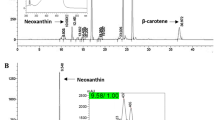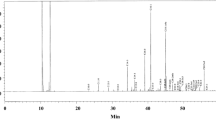Abstract
Hepatocytes exposed to an oxidative stressor such as hydrogen peroxide (H2O2) are potentially sensitized to cell death; thus, reactive oxygen species (ROS) are considered to be critical mediators of liver damage. Zingiber officinale Roscoe (ZO), also known as ginger, is cultivated commercially in China, India, Korea, and other parts of the world. In addition, it is used as a spice and flavoring agent and is also purported to possess a number of medicinal properties. In the present study, we examined the protective effect of ZO against cell damage caused by H2O2-induced oxidative stress. ZO reduced H2O2-induced apoptotic signals and the levels of intracellular ROS. ZO pretreatment also increased the phosphorylation of c-Jun, and JNK kinase. The expression of heme oxygenase-1 (HO-1) and heat shock protein 72 (HSP72) were increased by ZO pretreatment more than H2O2 treatment. In addition, siRNA-mediated knockdown of HO-1 and HSP72 decreased protective effect of ZO pretreatment. Our data suggest that ZO decreases ROS levels and the expressions of HO-1 and HSP72 are involved in the hepatocyte protective function of ZO against H2O2.
Similar content being viewed by others
References
Waris, G. and H. Ahsan (2006) Reactive oxygen species: Role in the development of cancer and various chronic conditions. J. Carcinog. 5: 14.
Sastre, J., G. Serviddio, J. Pereda, J. B. Minana, A. Arduini, G. Vendemiale, G. Poli, F. V. Pallardo, and J. Vina (2007) Mitochondrial function in liver disease. Front. Biosci. 12: 1200–1209.
Xu, Y., C. Bradham, D. A. Brenner, and M. J. Czaja (1997) Hydrogen peroxide-induced liver cell necrosis is dependent on AP-1 activation. Am. J. Physiol. 273: 795–803.
Zheng, Y., Y. Liu, J. Ge, X. Wang, L. Liu, Z. Bu, and P. Liu (2010) Resveratrol protects human lens epithelial cells against H2O2-induced oxidative stress by increasing catalase, SOD-1, and HO-1 expression. Mol. Vis. 16: 1467–1474.
Zhang, L., H. Jiang, X. Gao, Y. Zou, M. Liu, Y. Liang, Y. Yu, W. Zhu, H. Chen, and J. Ge (2011) Heat shock transcription factor-1 inhibits H2O2-induced apoptosis via down-regulation of reactive oxygen species in cardiac myocytes. Mol. Cell. Biochem. 347: 21–28.
Voloboueva, L. A., M. Duan, Y. Ouyang, J. F. Emery, C. Stoy, and R. G. Giffard (2008) Overexpression of mitochondrial Hsp70/Hsp75 protects astrocytes against ischemic injury in vitro. J. Cereb. Blood Flow Metab. 28: 1009–1016.
Kuo, H. T., H. W. Chen, H. H. Hsiao, and H. C. Chen (2009) Heat shock response protects human peritoneal mesothelial cells from dialysate-induced oxidative stress and mitochondrial injury. Nephrol. Dia.l Transplant. 24: 1799–1809.
Rost, D., A. Welker, J. Welker, G. Millonig, I. Berger, F. Autschbach, D. Schuppan, and S. Mueller (2007) Liver-homing of purified glucose oxidase: A novel in vivo model of physiological hepatic oxidative stress (H2O2). J. Hepatol. 46: 482–491.
Wu, D. and A. I. Cederbaum (2003) Alcohol, oxidative stress, and free radical damage. Alcohol Res. Health 27: 277–284.
Zhang, M., B. H. Zhang, L. Chen, and W. An (2002) Overexpression of heme oxygenase-1 protects smooth muscle cells against oxidative injury and inhibits cell proliferation. Cell Res. 12: 123–132.
Peng, L., L. Mundada, J. M. Stomel, J. J. Liu, J. Sun, S. F. Yet, and W. P. Fay (2004) Induction of heme oxygenase-1 expression inhibits platelet-dependent thrombosis. Antioxid. Redox Signal. 6: 729–735.
McNally, S. J., E. M. Harrison, J. A. Ross, O. J. Garden, and S. J. Wigmore (2006) Curcumin induces heme oxygenase-1 in hepatocytes and is protective in simulated cold preservation and warm reperfusion injury. Transplantation 81: 623–626.
Erdmann, K., B. W. Cheung, S. Immenschuh, and H. Schroder (2008) Heme oxygenase-1 is a novel target and antioxidant mediator of S-adenosylmethionine. Biochem. Biophys. Res. Commun. 368: 937–941.
Vallabhaneni, R., D. J. Kaczorowski, M. D. Yaakovian, J. Rao, and B. S. Zuckerbraun (2010) Heme oxygenase 1 protects against hepatic hypoxia and injury from hemorrhage via regulation of cellular respiration. Shock 33: 274–281.
Oh, S. Y., J. H. Kim, M. J. Park, S. M. Kim, C. S. Yoon, Y. M. Joo, J. S. Park, S. I. Han, H. G. Park, and H. S. Kang (2005) Induction of heat shock protein 72 in C6 glioma cells by methyl jasmonate through ROS-dependent heat shock factor 1 activation. Int. J. Mol. Med. 16: 833–839.
Ohkawara, T., H. Takeda, M. Nishiwaki, J. Nishihira, and M. Asaka (2006) Protective effects of heat shock protein 70 induced by geranylgeranylacetone on oxidative injury in rat intestinal epithelial cells. Scand. J. Gastroenterol. 41: 312–317.
Lee, K. J., Y. M. Kim, D. Y. Kim, D. Jeoung, K. Han, S. -T. Lee, Y. -S. Lee, K. H. Park, J. H. Park, D. J. Kim, and J. -H. Hahn (2006) Release of heat shock protein 70 (Hsp70) and the effects of extracellular Hsp70 on matric metalloproteinase-9 expression in human monocytic U937 cells. Experimental Mol. Med. 38: 364–374.
Escobar, M. C., V. Souza, L. Bucio, E. Hernandez, L. E. Gomez- Quiroz, and R. M. C. Gutierrez (2009) MAPK activation is involved in cadmium-induced Hsp70 expression in HepG2 cells. Toxicol. Mech. Methods 19: 503–509.
Huang, Z. S. (2002) Zhang yae xue. Ren min wei sheng chu ban she 39.
Ajith, T. A., U. Hema, and M. S. Aswathy (2007) Zingiber officinale Roscoe prevents acetaminophen-induced acute hepatotoxicity by enhancing hepatic antioxidant status. Food Chem. Toxicol. 45: 2267–2272.
Shati, A. A. and F. G. Elsaid (2009) Effects of water extracts of thyme (Thymus vulgaris) and ginger (Zingiber officinale Roscoe) on alcohol abuse. Food Chem. Toxicol. 47: 1945–1949.
Ansari, M. N., U. Bhandari, and K. K. Pillai (2006) Ethanolic Zingiber officinale R: Extract pretreatment alleviates isoproterenol-induced oxidative myocardial necrosis in rats. Indian J. Exp. Biol. 44: 892–897.
Vijaya Padma, V., S. Arul Diana Christie, and K. M. Ramkuma (2007) Induction of apoptosis by ginger in HEp-2 cell line is mediated by reactive oxygen species. Basic Clin. Pharmacol. Toxicol. 100: 302–307.
Matsura, T., M. Kai, Y. Fujii, H. Ito, and K. Yamada (1999) Hydrogen peroxide-induced apoptosis in HL-60 cells requires caspase-3 activation. Free Radic. Res. 30: 73–83.
Zhuang, S., Y. Yan, R. A. Daubert, J. Han, and R. G. Schnellmann (2007) ERK promotes hydrogen peroxide-induced apoptosis through caspase-3 activation and inhibition of Akt in renal epithelial cells. Am. J. Physiol. Renal. Physiol. 292: 440–447.
Yang, J., X. Liu, K. Bhalla, C. N. Kim, A. M. Ibrado, J. Cai, T. I. Peng, D. P. Jones, and X. Wang (1997) Prevention of apoptosis by Bcl-2: Release of cytochrome c from mitochondria blocked. Science 275: 1129–1132.
Smolka, M. B., C. C. Zoppi, A. A. Alves, L. R. Silveira, S. Marangoni, L. Pereira-Da-Silva, J. C. Novello, and D. V. Macedo (2000) HSP72 as a complementary protection against oxidative stress induced by exercise in the soleus muscle of rats. Am. J. Physiol. Regul. Integr. Comp. Physiol. 279: 1539–1545.
Chen, T., J. Guo, C. Han, M. Yang, and X. Cao (2009) Heat shock protein 70, released from heat-stressed tumor cells, initiates antitumor immunity by inducing tumor cell chemokine production and activating dendritic cells via TLR4 pathway. J. Immunol. 182: 1449–1459.
Lamb, J. A., J. J. Ventura, P. Hess, R. A. Flavell, and R. J. Davis (2003) JunD mediates survival signaling by the JNK signal transduction pathway. Mol. Cell 11: 1479–1489.
Author information
Authors and Affiliations
Corresponding author
Rights and permissions
About this article
Cite this article
Oh, S.Y., Lee, Jh., Lee, J.S. et al. An aqueous extract of Zingiber officinale Roscoe protects mouse primary hepatic cells against hydrogen peroxide-induced oxidative stress. Biotechnol Bioproc E 17, 168–175 (2012). https://doi.org/10.1007/s12257-011-0433-8
Received:
Revised:
Accepted:
Published:
Issue Date:
DOI: https://doi.org/10.1007/s12257-011-0433-8




